Alfa Romeo GT 2005 Owner handbook (in English)
Manufacturer: ALFA ROMEO, Model Year: 2005, Model line: GT, Model: Alfa Romeo GT 2005Pages: 307, PDF Size: 6.05 MB
Page 41 of 307
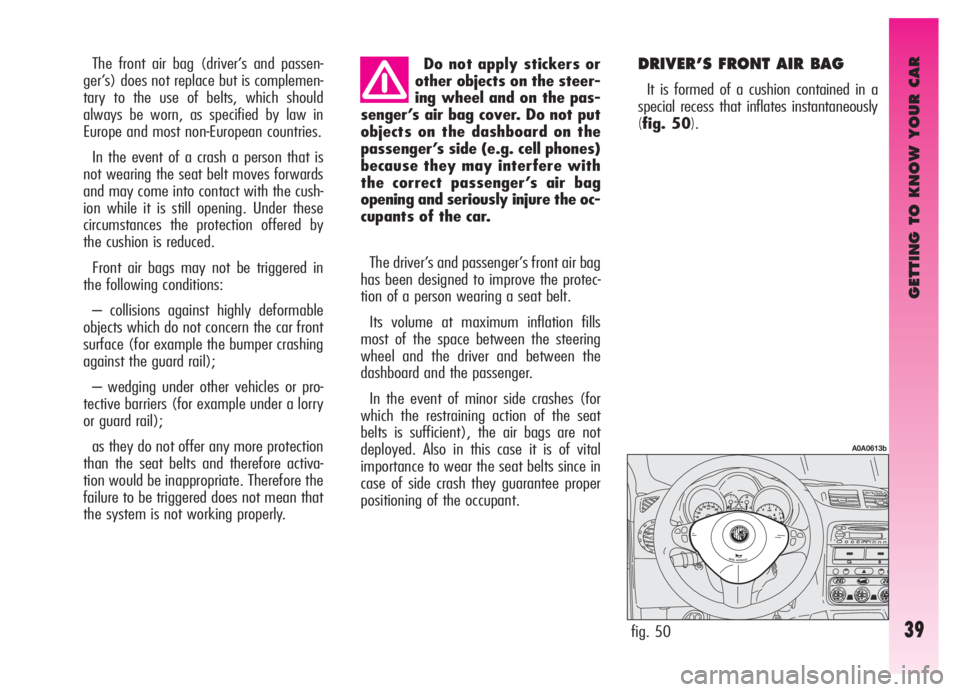
GETTING TO KNOW YOUR CAR
39
Do not apply stickers or
other objects on the steer-
ing wheel and on the pas-
senger’s air bag cover. Do not put
objects on the dashboard on the
passenger’s side (e.g. cell phones)
because they may interfere with
the correct passenger’s air bag
opening and seriously injure the oc-
cupants of the car.
The driver’s and passenger’s front air bag
has been designed to improve the protec-
tion of a person wearing a seat belt.
Its volume at maximum inflation fills
most of the space between the steering
wheel and the driver and between the
dashboard and the passenger.
In the event of minor side crashes (for
which the restraining action of the seat
belts is sufficient), the air bags are not
deployed. Also in this case it is of vital
importance to wear the seat belts since in
case of side crash they guarantee proper
positioning of the occupant. DRIVER’S FRONT AIR BAG
It is formed of a cushion contained in a
special recess that inflates instantaneously
(fig. 50). The front air bag (driver’s and passen-
ger’s) does not replace but is complemen-
tary to the use of belts, which should
always be worn, as specified by law in
Europe and most non-European countries.
In the event of a crash a person that is
not wearing the seat belt moves forwards
and may come into contact with the cush-
ion while it is still opening. Under these
circumstances the protection offered by
the cushion is reduced.
Front air bags may not be triggered in
the following conditions:
– collisions against highly deformable
objects which do not concern the car front
surface (for example the bumper crashing
against the guard rail);
– wedging under other vehicles or pro-
tective barriers (for example under a lorry
or guard rail);
as they do not offer any more protection
than the seat belts and therefore activa-
tion would be inappropriate. Therefore the
failure to be triggered does not mean that
the system is not working properly.
fig. 50
A0A0613b
Page 42 of 307
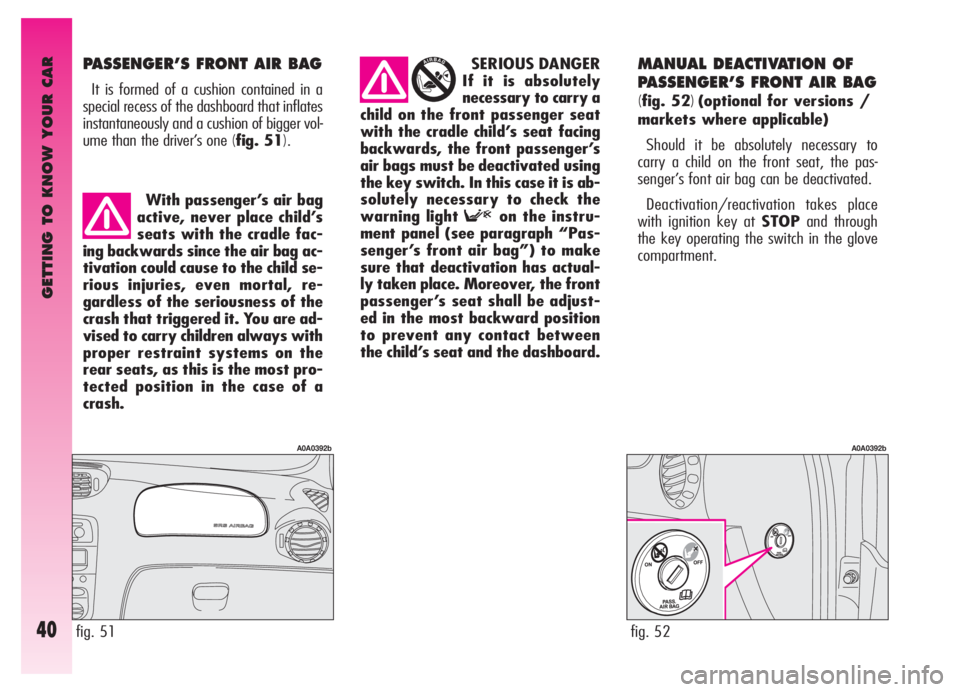
GETTING TO KNOW YOUR CAR
40
PASSENGER’S FRONT AIR BAG
It is formed of a cushion contained in a
special recess of the dashboard that inflates
instantaneously and a cushion of bigger vol-
ume than the driver’s one
(fig. 51).
MANUAL DEACTIVATION OF
PASSENGER’S FRONT AIR BAG
(
fig. 52)(optional for versions /
markets where applicable)
Should it be absolutely necessary to
carry a child on the front seat, the pas-
senger’s font air bag can be deactivated.
Deactivation/reactivation takes place
with ignition key at STOPand through
the key operating the switch in the glove
compartment. SERIOUS DANGER
If it is absolutely
necessary to carry a
child on the front passenger seat
with the cradle child’s seat facing
backwards, the front passenger’s
air bags must be deactivated using
the key switch. In this case it is ab-
solutely necessary to check the
warning light Fon the instru-
ment panel (see paragraph “Pas-
senger’s front air bag”) to make
sure that deactivation has actual-
ly taken place. Moreover, the front
passenger’s seat shall be adjust-
ed in the most backward position
to prevent any contact between
the child’s seat and the dashboard.
fig. 51
A0A0392b
fig. 52
A0A0392b
With passenger’s air bag
active, never place child’s
seats with the cradle fac-
ing backwards since the air bag ac-
tivation could cause to the child se-
rious injuries, even mortal, re-
gardless of the seriousness of the
crash that triggered it. You are ad-
vised to carry children always with
proper restraint systems on the
rear seats, as this is the most pro-
tected position in the case of a
crash.
Page 43 of 307
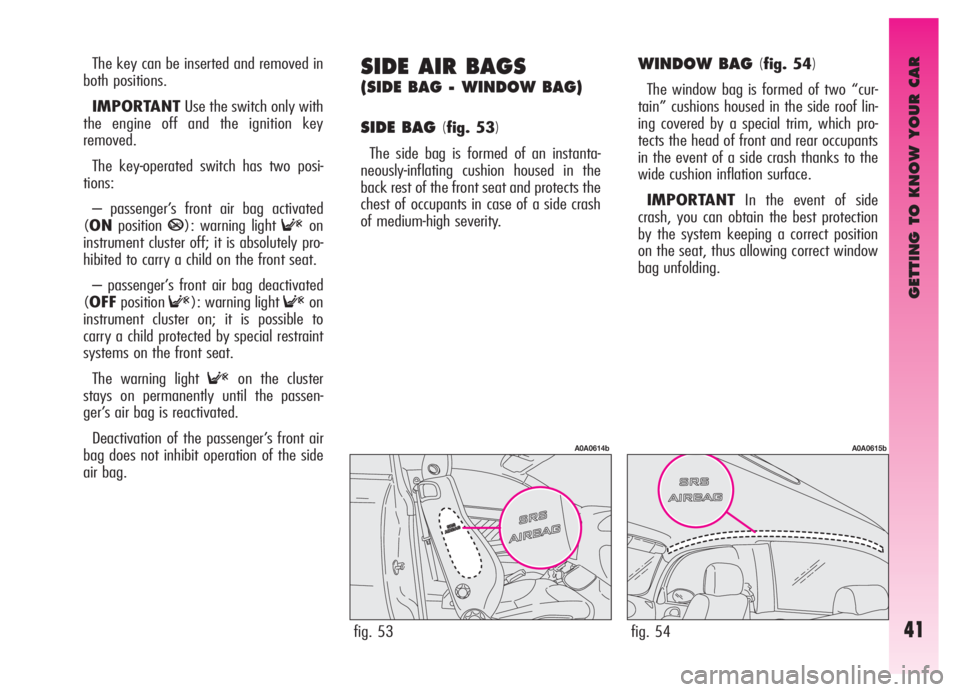
GETTING TO KNOW YOUR CAR
41
The key can be inserted and removed in
both positions.
IMPORTANTUse the switch only with
the engine off and the ignition key
removed.
The key-operated switch has two posi-
tions:
– passenger’s front air bag activated
(ONpositionP): warning light
Fon
instrument cluster off; it is absolutely pro-
hibited to carry a child on the front seat.
– passenger’s front air bag deactivated
(OFFposition
F): warning light Fon
instrument cluster on; it is possible to
carry a child protected by special restraint
systems on the front seat.
The warning light
Fon the cluster
stays on permanently until the passen-
ger’s air bag is reactivated.
Deactivation of the passenger’s front air
bag does not inhibit operation of the side
air bag.
SIDE AIR BAGS
(SIDE BAG - WINDOW BAG)
SIDE BAG (
fig. 53)
The side bag is formed of an instanta-
neously-inflating cushion housed in the
back rest of the front seat and protects the
chest of occupants in case of a side crash
of medium-high severity.
WINDOW BAG (fig. 54)
The window bag is formed of two “cur-
tain” cushions housed in the side roof lin-
ing covered by a special trim, which pro-
tects the head of front and rear occupants
in the event of a side crash thanks to the
wide cushion inflation surface.
IMPORTANTIn the event of side
crash, you can obtain the best protection
by the system keeping a correct position
on the seat, thus allowing correct window
bag unfolding.
fig. 53
A0A0614b
fig. 54
A0A0615b
Page 44 of 307
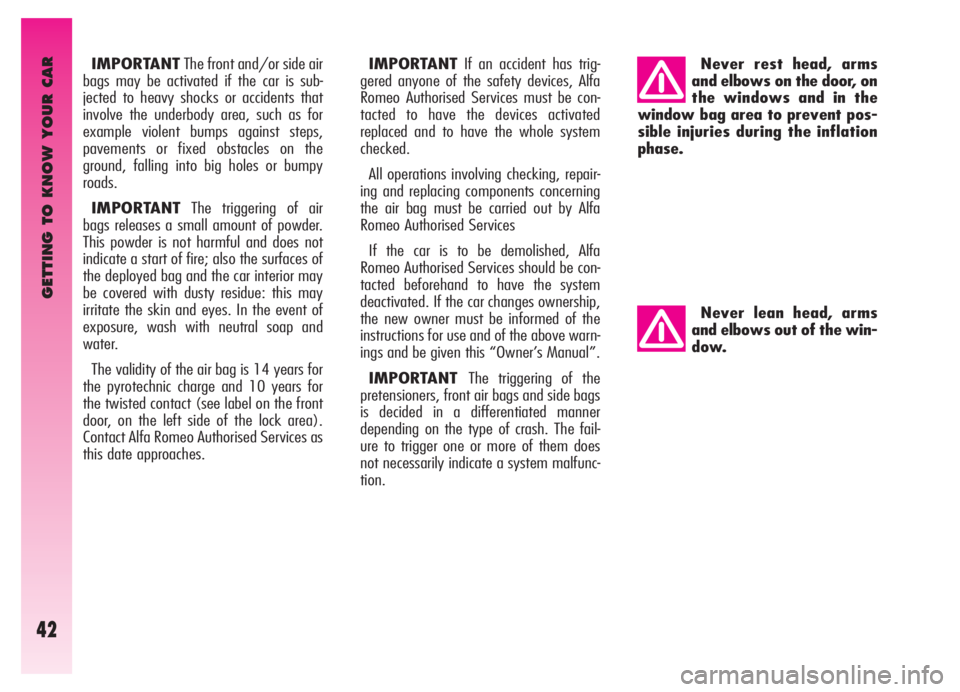
GETTING TO KNOW YOUR CAR
42
IMPORTANTThe front and/or side air
bags may be activated if the car is sub-
jected to heavy shocks or accidents that
involve the underbody area, such as for
example violent bumps against steps,
pavements or fixed obstacles on the
ground, falling into big holes or bumpy
roads.
IMPORTANTThe triggering of air
bags releases a small amount of powder.
This powder is not harmful and does not
indicate a start of fire; also the surfaces of
the deployed bag and the car interior may
be covered with dusty residue: this may
irritate the skin and eyes. In the event of
exposure, wash with neutral soap and
water.
The validity of the air bag is 14 years for
the pyrotechnic charge and 10 years for
the twisted contact (see label on the front
door, on the left side of the lock area).
Contact Alfa Romeo Authorised Services as
this date approaches.IMPORTANTIf an accident has trig-
gered anyone of the safety devices, Alfa
Romeo Authorised Services must be con-
tacted to have the devices activated
replaced and to have the whole system
checked.
All operations involving checking, repair-
ing and replacing components concerning
the air bag must be carried out by Alfa
Romeo Authorised Services
If the car is to be demolished, Alfa
Romeo Authorised Services should be con-
tacted beforehand to have the system
deactivated. If the car changes ownership,
the new owner must be informed of the
instructions for use and of the above warn-
ings and be given this “Owner’s Manual”.
IMPORTANT The triggering of the
pretensioners, front air bags and side bags
is decided in a differentiated manner
depending on the type of crash. The fail-
ure to trigger one or more of them does
not necessarily indicate a system malfunc-
tion.Never rest head, arms
and elbows on the door, on
the windows and in the
window bag area to prevent pos-
sible injuries during the inflation
phase.
Never lean head, arms
and elbows out of the win-
dow.
Page 45 of 307
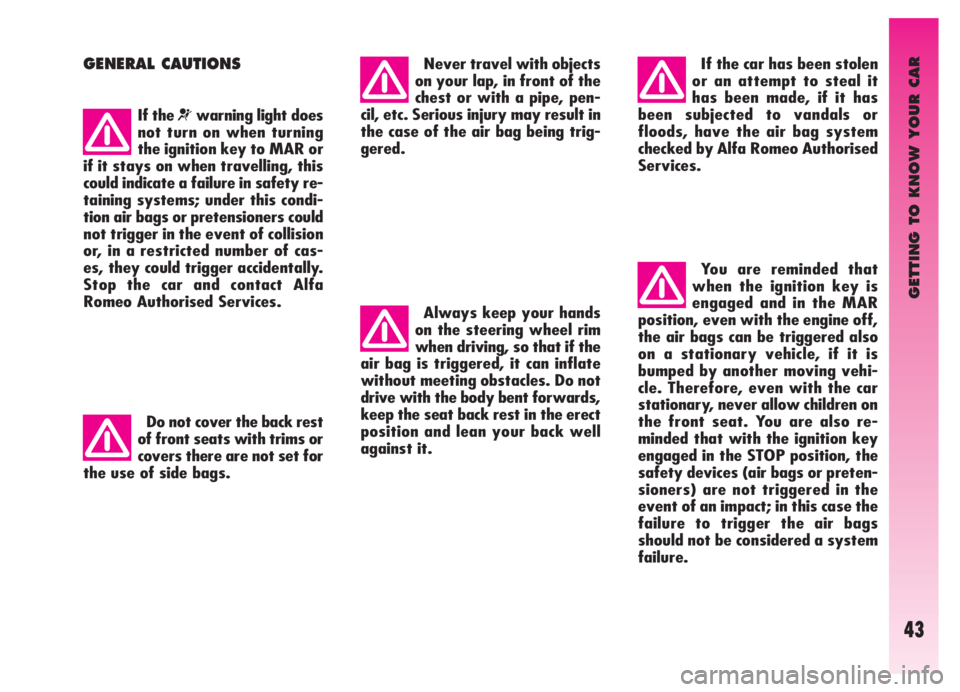
GETTING TO KNOW YOUR CAR
43
GENERAL CAUTIONS
If the ¬warning light does
not turn on when turning
the ignition key to MAR or
if it stays on when travelling, this
could indicate a failure in safety re-
taining systems; under this condi-
tion air bags or pretensioners could
not trigger in the event of collision
or, in a restricted number of cas-
es, they could trigger accidentally.
Stop the car and contact Alfa
Romeo Authorised Services.
Do not cover the back rest
of front seats with trims or
covers there are not set for
the use of side bags.Never travel with objects
on your lap, in front of the
chest or with a pipe, pen-
cil, etc. Serious injury may result in
the case of the air bag being trig-
gered.
Always keep your hands
on the steering wheel rim
when driving, so that if the
air bag is triggered, it can inflate
without meeting obstacles. Do not
drive with the body bent forwards,
keep the seat back rest in the erect
position and lean your back well
against it.
If the car has been stolen
or an attempt to steal it
has been made, if it has
been subjected to vandals or
floods, have the air bag system
checked by Alfa Romeo Authorised
Services.
You are reminded that
when the ignition key is
engaged and in the MAR
position, even with the engine off,
the air bags can be triggered also
on a stationary vehicle, if it is
bumped by another moving vehi-
cle. Therefore, even with the car
stationary, never allow children on
the front seat. You are also re-
minded that with the ignition key
engaged in the STOP position, the
safety devices (air bags or preten-
sioners) are not triggered in the
event of an impact; in this case the
failure to trigger the air bags
should not be considered a system
failure.
Page 46 of 307
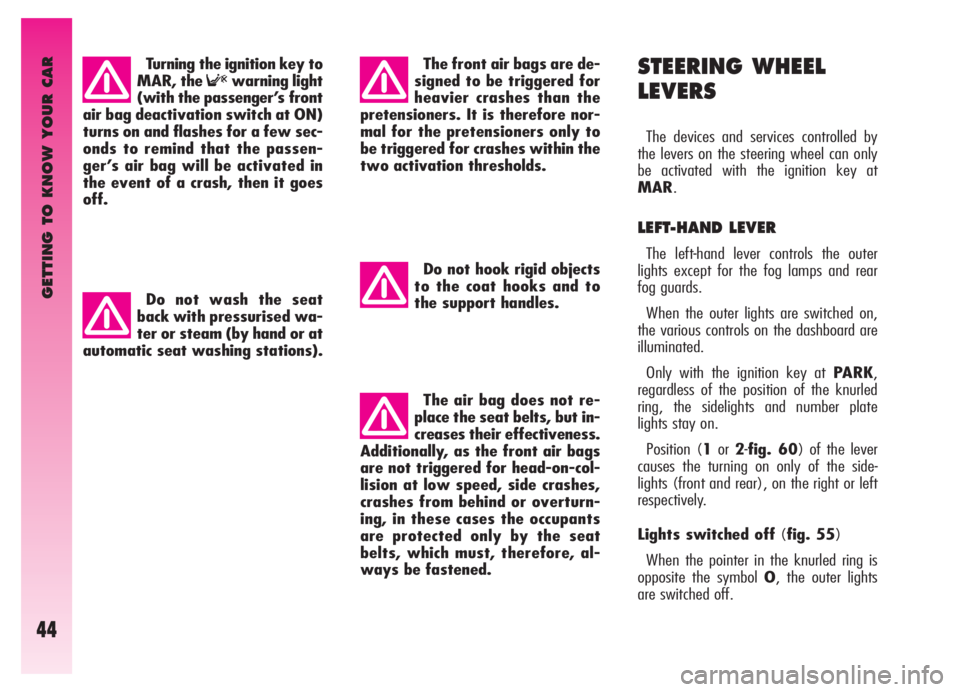
GETTING TO KNOW YOUR CAR
44
STEERING WHEEL
LEVERS
The devices and services controlled by
the levers on the steering wheel can only
be activated with the ignition key at
MAR.
LEFT-HAND LEVER
The left-hand lever controls the outer
lights except for the fog lamps and rear
fog guards.
When the outer lights are switched on,
the various controls on the dashboard are
illuminated.
Only with the ignition key at PARK,
regardless of the position of the knurled
ring, the sidelights and number plate
lights stay on.
Position (1or2-fig. 60) of the lever
causes the turning on only of the side-
lights (front and rear), on the right or left
respectively.
Lights switched off(fig. 55)
When the pointer in the knurled ring is
opposite the symbol O, the outer lights
are switched off. Turning the ignition key to
MAR, the
Fwarning light
(with the passenger’s front
air bag deactivation switch at ON)
turns on and flashes for a few sec-
onds to remind that the passen-
ger’s air bag will be activated in
the event of a crash, then it goes
off.The front air bags are de-
signed to be triggered for
heavier crashes than the
pretensioners. It is therefore nor-
mal for the pretensioners only to
be triggered for crashes within the
two activation thresholds.
Do not hook rigid objects
to the coat hooks and to
the support handles.
The air bag does not re-
place the seat belts, but in-
creases their effectiveness.
Additionally, as the front air bags
are not triggered for head-on-col-
lision at low speed, side crashes,
crashes from behind or overturn-
ing, in these cases the occupants
are protected only by the seat
belts, which must, therefore, al-
ways be fastened. Do not wash the seat
back with pressurised wa-
ter or steam (by hand or at
automatic seat washing stations).
Page 47 of 307

GETTING TO KNOW YOUR CAR
45
Sidelights(fig. 56)
The sidelights are switched on by turning
the knurled ring from Oto
6.
The
3warning light on the instrument
cluster will come on at the same time.
Dipped-beam headlights (fig. 57)
These are switched on by turning the
knurled ring from
6to2.
fig. 55
A0A0063b
fig. 56
A0A0064b
Main beams (fig. 58)
To turn the main beams on, set the
knurled ring to position
2and push the
lever towards the dashboard (stable posi-
tion); warning light
1on the instrument
panel will turn on.
To set dipped-beams back pull the lever
towards the steering wheel.
fig. 57
A0A0065b
fig. 58
A0A0066b
When the dipped beam headlights and
the fog lamps are switched on, the outer
light control unit (integrated in the Body
Computer) works according to the follow-
ing logics:
– turning on the main beams, the
dipped beams turn off while the fog lamps
stay on, when restoring the starting con-
dition at dipped beam setting;
or
– turning on the main beams, the fog
lamps turn off and then turn on again
automatically as the main beams are
switched off.
Therefore, in the event of Body
Computer replacement, the outer light
operating logic may be different.
fig. 59
A0A0067b
Page 48 of 307
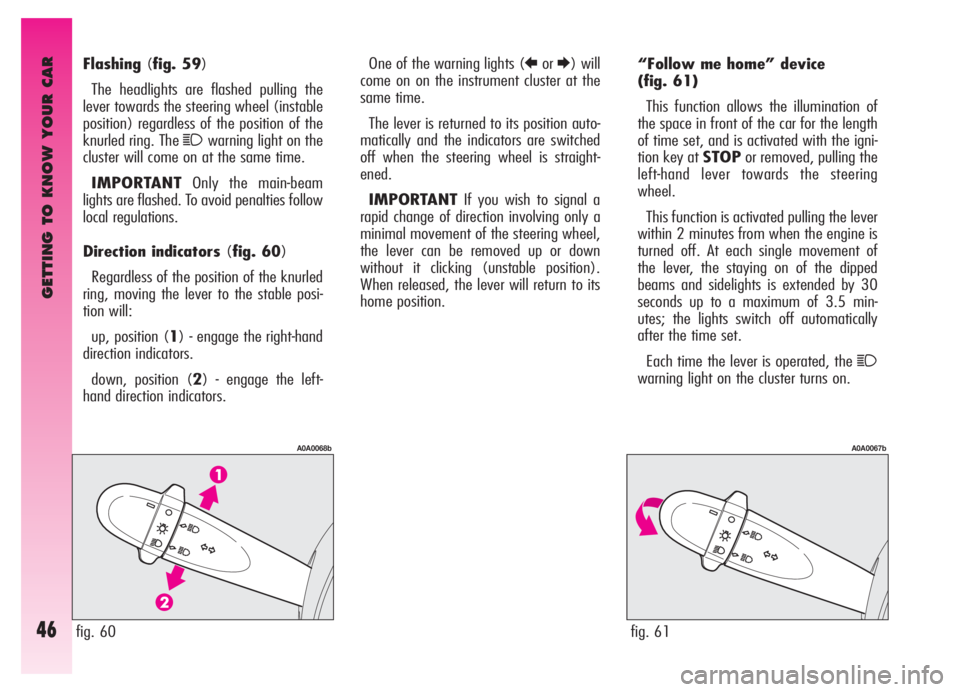
GETTING TO KNOW YOUR CAR
46
“Follow me home” device
(fig. 61)
This function allows the illumination of
the space in front of the car for the length
of time set, and is activated with the igni-
tion key at STOPor removed, pulling the
left-hand lever towards the steering
wheel.
This function is activated pulling the lever
within 2 minutes from when the engine is
turned off. At each single movement of
the lever, the staying on of the dipped
beams and sidelights is extended by 30
seconds up to a maximum of 3.5 min-
utes; the lights switch off automatically
after the time set.
Each time the lever is operated, the
1
warning light on the cluster turns on. Flashing(fig. 59)
The headlights are flashed pulling the
lever towards the steering wheel (instable
position) regardless of the position of the
knurled ring. The
1warning light on the
cluster will come on at the same time.
IMPORTANTOnly the main-beam
lights are flashed. To avoid penalties follow
local regulations.
Direction indicators (fig. 60)
Regardless of the position of the knurled
ring, moving the lever to the stable posi-
tion will:
up, position (1) - engage the right-hand
direction indicators.
down, position (2) - engage the left-
hand direction indicators.One of the warning lights (
RorE) will
come on on the instrument cluster at the
same time.
The lever is returned to its position auto-
matically and the indicators are switched
off when the steering wheel is straight-
ened.
IMPORTANTIf you wish to signal a
rapid change of direction involving only a
minimal movement of the steering wheel,
the lever can be removed up or down
without it clicking (unstable position).
When released, the lever will return to its
home position.
fig. 61
A0A0067b
fig. 60
A0A0068b
Page 49 of 307
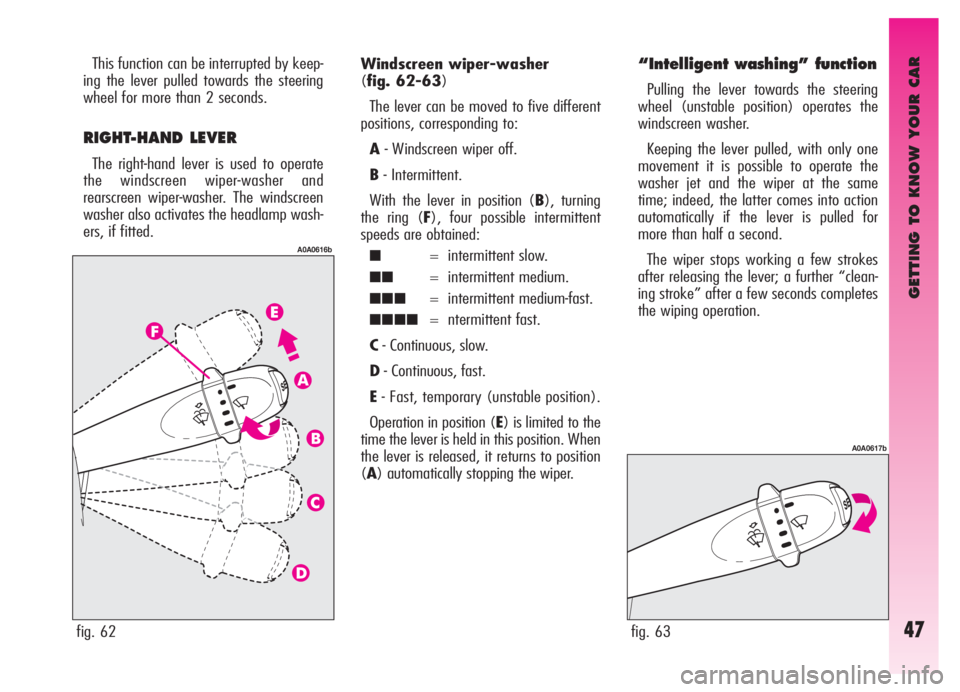
GETTING TO KNOW YOUR CAR
47
This function can be interrupted by keep-
ing the lever pulled towards the steering
wheel for more than 2 seconds.
RIGHT-HAND LEVER
The right-hand lever is used to operate
the windscreen wiper-washer and
rearscreen wiper-washer. The windscreen
washer also activates the headlamp wash-
ers, if fitted.
fig. 62
A0A0616b
Windscreen wiper-washer
(fig. 62-63)
The lever can be moved to five different
positions, corresponding to:
A- Windscreen wiper off.
B- Intermittent.
With the lever in position (B), turning
the ring (F), four possible intermittent
speeds are obtained:
■= intermittent slow.
■■= intermittent medium.
■■■= intermittent medium-fast.
■■■■= ntermittent fast.
C- Continuous, slow.
D- Continuous, fast.
E- Fast, temporary (unstable position).
Operation in position (E) is limited to the
time the lever is held in this position. When
the lever is released, it returns to position
(A) automatically stopping the wiper.
“Intelligent washing” function
Pulling the lever towards the steering
wheel (unstable position) operates the
windscreen washer.
Keeping the lever pulled, with only one
movement it is possible to operate the
washer jet and the wiper at the same
time; indeed, the latter comes into action
automatically if the lever is pulled for
more than half a second.
The wiper stops working a few strokes
after releasing the lever; a further “clean-
ing stroke” after a few seconds completes
the wiping operation.
fig. 63
A0A0617b
Page 50 of 307

GETTING TO KNOW YOUR CAR
48
At each start, the rain sensor automati-
cally stabilises at a temperature of about
40°C to eliminate any condensation from
the control surface and prevent the forma-
tion of ice.
The rain sensor is able to detect and
automatically adapt to the presence of the
following particular conditions which
require different sensitivity:
– impurities on the control surface (salt,
dirt, etc.);
– streaks of water caused by worn wiper
blades;
– difference between day and night (the
human eye is more disturbed during the
night by the wet glass surface). Rain sensor(fig. 64)
The rain sensor (A), fitted only on cer-
tain versions, is an electronic device com-
bined with the windscreen wiper which
has the purpose of automatically adjusting
the number of wipes during intermittent
operation to the intensity of the rain.
All the other functions controlled by the
right-hand lever remain unchanged.
The rain sensor is activated automatical-
ly moving the right-hand lever to position
(B-fig. 62) and it has a range of adjust-
ment that gradually varies between wiper
stationary (no wiping) when the wind-
screen is dry, to wiper at first continuous
speed (continuous, slow) with heavy rain.Turning the knurled ring (F-fig. 62) it
is possible to increase the sensitivity of the
rain sensor, obtaining a quicker change
from stationary, when the windscreen is
dry, to first continuous speed (continuous,
slow).
Operating the windscreen washer with
the rain sensor activated (lever at position
B) the normal washing cycle is performed
at the end of which the rain sensor
resumes its normal automatic function.
Turning the ignition key to STOPthe
rain sensor is deactivated and the next
time the engine is started (MAR posi-
tion) it will not be reactivated even if the
lever has remained in position (B). In this
case to activate the rain sensor, simply
move the lever to (A) or (C) and then
back to (B).
When the rain sensor is reactivated in
this way, the wiper performs at least one
stroke, even if the windscreen is dry, to
indicate that reactivation has occurred.
The rain sensor is located behind the
inner rear-view mirror in contact with the
windscreen and inside the area cleaned by
the wiper and it controls an electronic con-
trol unit which in turn controls the wiper
motor.
fig. 64
A0A0331b